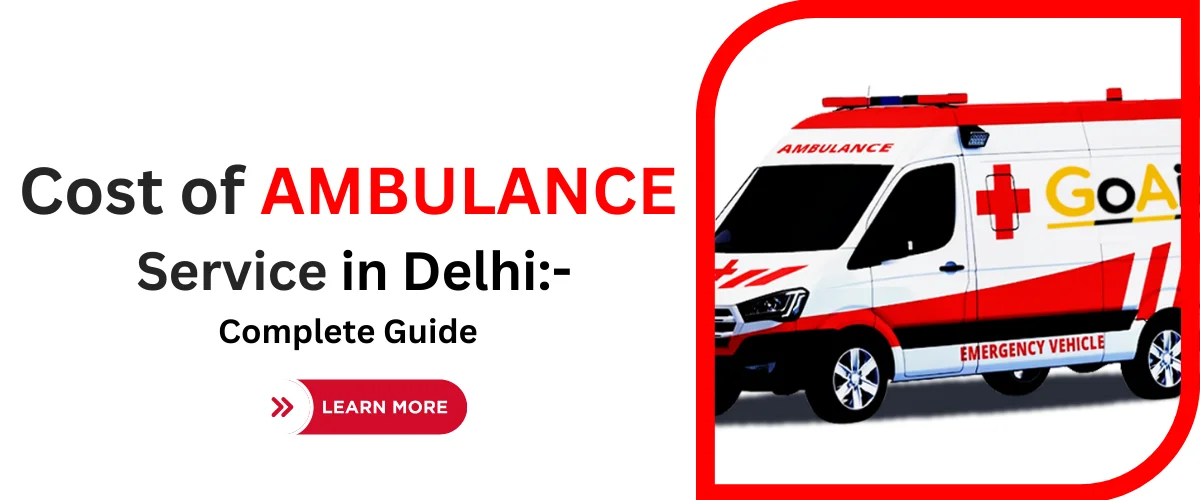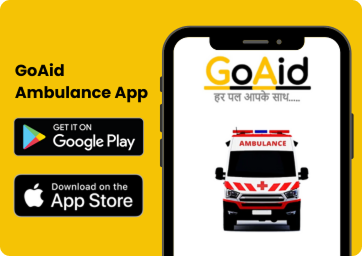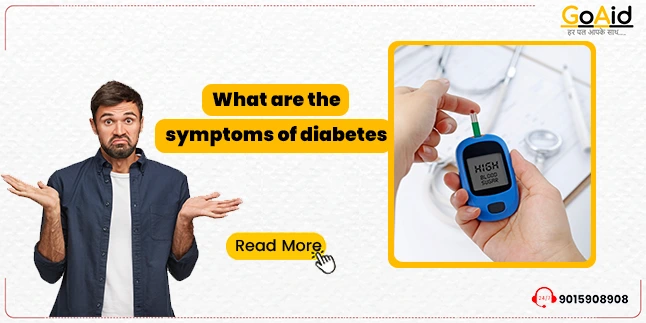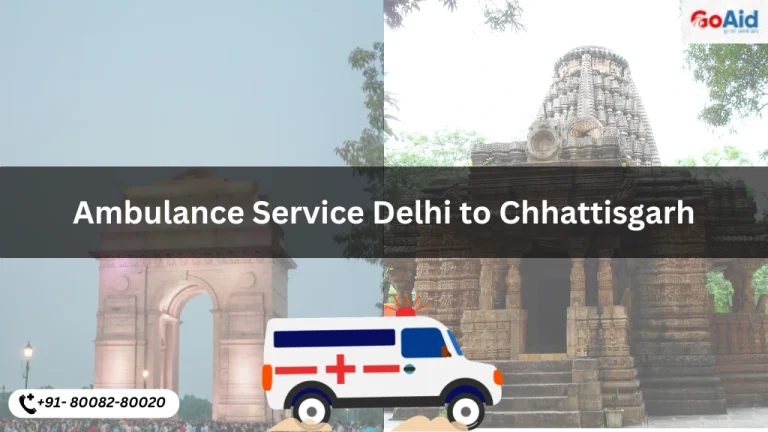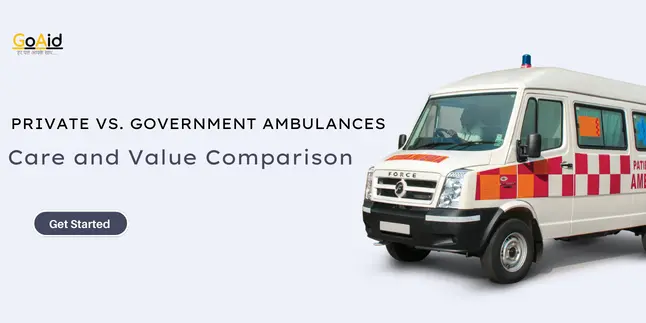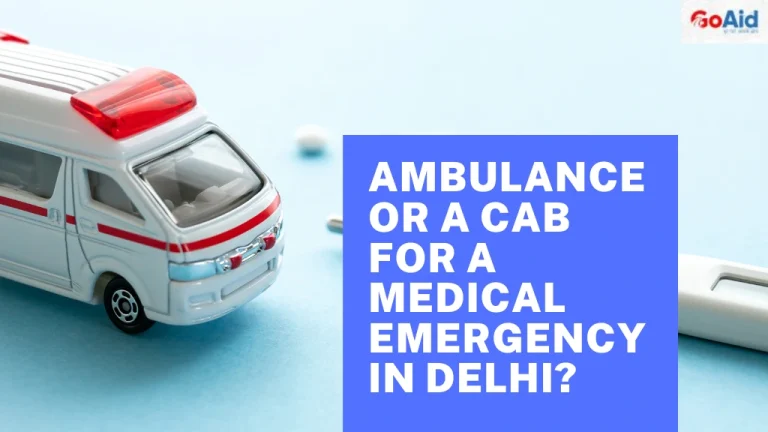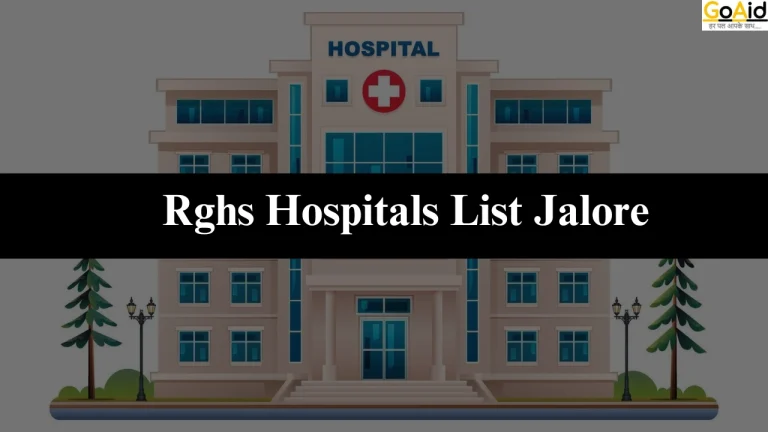In India, people consider a thing great if that thing gets considered great in Delhi. Similarly, if an Ambulance is considered affordable in Delhi, then it will be considered an Affordable Ambulance Service in India. This is why people generally ask for the Cost of Ambulance Service in Delhi.
Here, in this blog, we have presented you with a complete guide to the Cost of ambulance service in Delhi. If you are also looking for the Cost of ambulance service in Delhi, then this blog is a complete guide for you.
So, letŌĆÖs start-
What is an Ambulance Service in Delhi?
An ambulance service in Delhi is a vital emergency medical transport system. It swiftly responds to urgent situations, transporting individuals to healthcare facilities. These services are equipped with life-saving equipment and trained personnel to provide immediate medical aid during transit.
In Delhi, both government and private entities offer ambulance services. Government services are often subsidized, providing emergency assistance via helpline numbers like 102 or 108.
Private ambulance services vary in cost, offering different levels of care such as Basic Life Support (BLS) or Advanced Life Support (ALS). Ambulance services in Delhi play a crucial role in ensuring timely medical intervention.
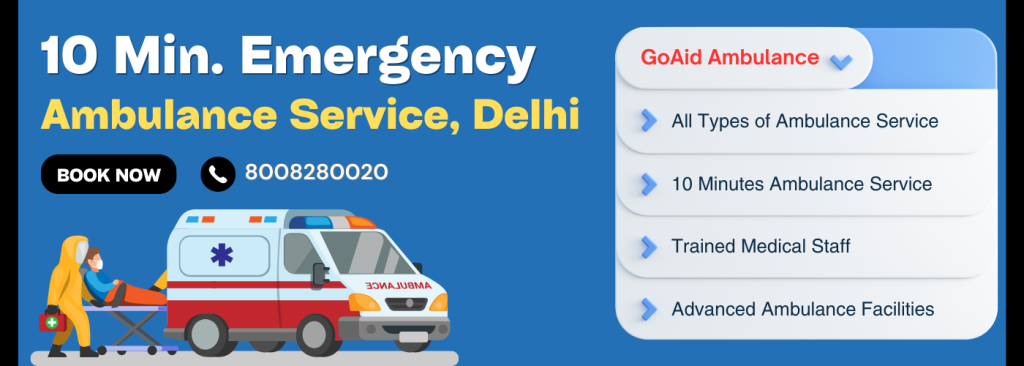
Cost Of Ambulance Service in Delhi
| Types of Ambulance | Price |
| Normal ambulance | 560-720 |
| ICU ambulance | 2200-2900 |
| oxygen Ambulance | 610-800 |
| Dead Body Mortury Van / Transfer | 580-750 |
| Dead Body Freezer Box on Rent | 2000-2900 |
| Train ambulance | 3100-6250 |
| Air Ambulance | 45000-900000 |
Types of Ambulance Services in Delhi – Cost of Ambulance Service in Delhi
We have added all the major types of ambulance services that can be available or you may find them serving in Delhi. We also have added a bar of price range (Approximate) for Each of them. We would like to add that GoAid Ambulance Services in Delhi provides all the types of Ambulance Services for Delhi, that we have listed below-
1. Basic Life Support (BLS) Ambulance
- Equipped with essential medical supplies like a stretcher, oxygen, and basic first aid.
- Staffed by trained paramedics capable of providing basic life-saving interventions.
- Suitable for non-critical medical situations, injuries, or routine patient transfers.
- Rapid response time for timely transportation to medical facilities.
- Cost-effective option for situations not requiring advanced medical support.
- Price Point: Starts from INR560
- Price Range: INR 560 – INR 720 (depending on distance and service provider)
2. Advanced Life Support (ALS) Ambulance
- Advanced medical equipment, including cardiac monitors, defibrillators, and medications.
- Manned by paramedics with specialized training in critical care and advanced life support.
- Critical for emergencies such as cardiac arrests, severe trauma, or acute medical conditions.
- Faster response times compared to BLS ambulances for high-priority situations.
- Higher cost due to advanced medical capabilities and skilled personnel.
- Price Point: Starts from INR 610
- Price Range: INR 610 – INR 800 (varying with distance and level of care)
3. Patient Transport Vehicle
- Designed for non-emergency transportation of stable patients.
- Comfortable and equipped for patients who don’t require immediate medical attention.
- Ideal for routine medical appointments, transfers between healthcare facilities, or post-hospital care.
- Affordable option for patients with mobility issues or those needing regular medical check-ups.
- Ensures safe and secure transportation without the urgency of emergency services.
- Price Point: Starts from INR 800
- Price Range: INR 800 – INR 4,000 (depending on distance and service provider)
4. Neonatal Ambulance
- Specially designed for transporting newborns and infants in need of intensive care.
- Equipped with neonatal incubators, monitors, and other specialized equipment.
- Staffed by neonatal nurses or medical professionals trained in pediatric care.
- Ensures a controlled environment for premature or critically ill infants during transport.
- Vital for transferring newborns between hospitals or to specialized neonatal care units.
- Price Point: Starts from INR 2,500
- Price Range: INR 2,500 – INR 8,000 (varying with distance and specialized equipment)
5. Cardiac Ambulance
- Specifically equipped for transporting patients with cardiac issues.
- Features advanced cardiac monitoring devices, defibrillators, and medications.
- Manned by paramedics or medical professionals with expertise in cardiac care.
- Swift and efficient transport for individuals experiencing heart-related emergencies.
- Reduces the time to access specialized cardiac care, improving the chances of recovery.
- Price Point: Starts from INR 3,500
- Price Range: INR 3,500 – INR 12,000 (depending on distance and cardiac care facilities)
6. Train Ambulance
- Facilitates the transportation of patients over extended distances via train.
- Ensures a cost-effective and efficient means for covering vast geographical areas.
- Provides a stable and controlled environment within train compartments for patient comfort.
- Suitable for patients who require medical supervision during prolonged journeys.
- Requires coordination with railway authorities to ensure a seamless transfer process.
- Availability of medical personnel and necessary equipment on the train.
- Price Point: Starts from INR 3100
- Price Range: INR 3100 – INR 6250 (depending on distance and train arrangement)
7. ICU Ventilator Ambulance
- Equipped with an Intensive Care Unit (ICU) setup, including ventilator support.
- Essential for transporting critically ill patients requiring constant respiratory assistance.
- Staffed by medical professionals trained in intensive care and ventilator management.
- Provides a mobile ICU environment to address critical medical conditions during transit.
- Ensures the availability and proper functioning of ventilators during the entire journey.
- Critical for patients dependent on mechanical ventilation for life support.
- Rapid response capabilities to address unforeseen medical emergencies during transit.
- Enables the transfer of patients to specialized medical facilities with ICU ventilator capabilities.
- Price Point: Starts from INR 2200
- Price Range: INR 2200 – INR 2900 (varying with distance and level of ICU support)
8. Air Ambulance
- Provides emergency air transport for swift transfer of patients, especially over long distances.
- Utilizes helicopters or fixed-wing aircraft for rapid response.
- Staffed by a specialized aero-medical team trained for in-flight patient care.
- Facilitates the transfer of patients to distant healthcare facilities quickly and efficiently.
- Requires coordination with helipads or airports for takeoff and landing.
- Ensures seamless transitions between ground and air transportation.
- Ideal for time-critical medical situations where ground transportation may be impractical.
- Reduces travel time significantly, improving the chances of timely medical intervention.
- Price Point: Starts from INR 45000
- Price Range: INR 45000 – INR 9,00,000 (depending on distance, aircraft type, and medical team requirements in air ambulance)
9. Emergency Ambulance
- Rapid response to urgent medical situations requiring immediate attention.
- Equipped with essential medical supplies to provide initial care during transit.
- Suitable for a wide range of emergencies, including accidents, cardiac events, and sudden illnesses.
- Provides a quick and efficient means of transporting patients to the nearest medical facility.
- Staffed by trained Emergency Medical Technicians capable of handling critical cases.
- Ensures a timely and effective response to emergencies.
- Allows for on-the-spot life-saving interventions, such as administering CPR or stabilizing trauma patients.
- Vital in situations where immediate medical attention can make a significant difference.
- Operates 24/7 to cater to emergencies at any time of the day or night.
- Essential for addressing unforeseen medical crises with urgency.
- Price Point: Starts from INR 1,500
- Price Range: INR 1,500 – INR 8,000 (depending on distance and urgency)
10. Dead Body Ambulance
- Provides dignified transportation for deceased individuals to mortuaries or funeral homes.
- Equipped to handle deceased bodies with respect and care.
- Adheres to legal and health regulations governing the transportation of deceased individuals.
- Ensures proper documentation and handling during the process.
- Some services may offer grief support services to the bereaved family during transportation.
- Compassionate staff trained to handle the sensitive nature of transporting deceased individuals.
- Services available for transportation from homes, hospitals, or accident sites.
- Ensures a reliable and respectful solution for deceased individuals.
- Price Point: Starts from INR 580
- Price Range: INR 580 – INR 750 (depending on distance and dead body ambulance service provider)
11. Dead Body Freezer Box Ambulance
- Equipped with a refrigerated compartment to preserve deceased bodies during transportation.
- Maintains the integrity of the body until it reaches the final destination.
- Provides a temperature-controlled environment to prevent decomposition during transit.
- Essential for longer journeys or when delays are anticipated.
- Adheres to health and safety standards for the transportation of deceased bodies.
- Ensures proper handling and preservation according to regulations.
- Manages all necessary documentation and legal requirements associated with transporting deceased individuals.
- Facilitates a smooth and compliant transfer process.
- Price Point: Starts from INR 2,000
- Price Range: INR 2,000 – INR 2900 (varying with distance and dead body freezer box ambulance requirements)
12. Oxygen Ambulance
- Specialized for patients requiring constant oxygen support during transportation.
- Equipped with oxygen delivery systems to meet the respiratory needs of the patient.
- Monitors respiratory parameters throughout the journey to ensure the patient’s well-being.
- Essential for individuals with respiratory conditions or those recovering from respiratory illnesses.
- Carries oxygen concentrators or cylinders to provide a continuous and controlled oxygen supply.
- Ensures a stable oxygen environment for patients during transit.
- Staffed by medical professionals trained in managing patients requiring oxygen therapy.
- Provides immediate response to any oxygen-related issues.
- Price Point: Starts from INR 2,500
- Price Range: INR 2,500 – INR 10,000 (depending on distance and oxygen support duration)
13. Surgery Ambulance
- Equipped to facilitate minor surgical procedures during transit.
- Provides a mobile environment for medical procedures that cannot be delayed.
- Maintains a sterile and controlled environment within the ambulance for surgical interventions.
- Suitable for procedures that require immediate attention.
- Staffed by a surgical team capable of performing minor surgeries during transport.
- Enhances the accessibility of surgical care in critical situations.
- Preparedness for emergency surgical interventions in response to sudden medical crises.
- Enables swift action when timely surgical procedures are essential.
- Price Point: Starts from INR 8,000
- Price Range: INR 8,000 – INR 20,000 (varying with the type of surgery and medical team involvement)
Government Ambulance & Private Ambulances in Delhi
1. Government Ambulance Service in Delhi
What is a Government Ambulance in Delhi?
A government ambulance in Delhi is a part of the public healthcare system, operated and funded by government authorities. These ambulances are often subsidized or provided free of charge to ensure accessibility for all citizens.
Types of Government Ambulances
A. Emergency Ambulance (108/102)
- Rapid response ambulances are available for emergencies.
- Equipped to handle a variety of medical situations and provide immediate care during transit.
B. Patient Transport Vehicle
- Non-emergency ambulances for routine patient transfers.
- Ensures comfortable transportation for individuals not in need of immediate medical attention.
C. Maternity Ambulance
- Specialized ambulances for pregnant women and expectant mothers.
- Equipped to handle childbirth emergencies during transit.
D. Janani Express
- Focuses on maternal and child health, providing transportation for pregnant women and newborns.
- Aims to reduce maternal and infant mortality rates by ensuring timely access to healthcare facilities.
E. CATS (Centralized Accident & Trauma Services) Ambulance
- Dedicated to handling accidents and trauma cases.
- Equipped to provide swift transportation and emergency medical care for trauma victims.
2. Private Ambulances in Delhi:
What is a Private Ambulance in Delhi?
Private ambulances in Delhi are operated by independent healthcare providers or organizations. These ambulances offer a range of services and are often equipped with advanced medical facilities. Private ambulance services may charge fees for their services.
Types of Private Ambulances
A. Advanced Life Support (ALS) Ambulance
Provides advanced medical support with equipment like cardiac monitors and ventilators.
Suitable for critical emergencies requiring immediate and sophisticated medical care.
B. Basic Life Support (BLS) Ambulance
Equipped with essential medical supplies for basic care.
Used in non-critical medical situations and routine patient transfers.
C. Air Ambulance
Emergency air transport for rapid patient transfer over long distances.
Utilizes helicopters or fixed-wing aircraft with specialized medical teams.
D. ICU Ventilator Ambulance
Features an Intensive Care Unit (ICU) setup with ventilator support.
Designed for critically ill patients requiring constant respiratory assistance.
E. Dead Body Freezer Box Ambulance
Equipped with a refrigerated compartment for transporting deceased bodies.
Maintains the integrity of the body for a longer duration, facilitating dignified transfer.
Factors that may affect the Cost of ambulance service in Delhi
Many factors affect the price or Cost of ambulance service in Delhi. We have added a few major factors below that are empowered to affect the Cost of ambulance service in Delhi-
1. Type of Ambulance
Different types of ambulances (e.g., Basic Life Support, Advanced Life Support, Air Ambulance) have varying levels of medical equipment and personnel, influencing the overall cost.
2. Distance Traveled
Charges may be based on the distance covered during transportation. Longer distances may incur higher costs.
3. Emergency vs. Non-Emergency
Emergency services may have different pricing structures compared to non-emergency transportation, reflecting the urgency and level of care required.
4. Time of Day
Some ambulance services may have different rates for day and night hours, with nighttime services potentially being more expensive.
5. Level of Medical Care
The complexity of medical care provided during transit, such as the use of advanced life support equipment or the need for specialized medical teams, can affect costs.
6. Additional Services
Additional services like oxygen administration, use of defibrillator, or specialized equipment may incur extra charges.
7. Type of Provider
Government ambulances may offer subsidized or free services, while private ambulance services may have varying pricing structures based on the provider.
8. Insurance Coverage
Health insurance coverage can impact the out-of-pocket expenses for ambulance services. Some providers may accept insurance, while others may require direct payment.
9. Geographical Accessibility
The accessibility of the location, such as urban or remote areas, may affect the cost due to transportation logistics and time involved.
10. Operational Costs
Ambulance services incur operational expenses, including fuel, maintenance, and staff salaries, which contribute to the overall cost structure.
Tips to Find Affordable Ambulance Service in Delhi
1. Seek quotes from multiple ambulance providers for price comparison.
2. Explore government ambulance services for potential cost savings.
3. Check health insurance coverage for possible financial assistance.
4. Consider non-emergency options for routine transfers to save costs.
5. Inquire about community-based or NGO-operated ambulance services.
6. Negotiate with providers for potential discounts or flexible payment options.
7. Choose Basic Life Support (BLS) services for more budget-friendly options.
8. Ask locals for recommendations on affordable ambulance services.
9. Plan and book in advance to avoid last-minute premium charges.
10. Research and be aware of any available subsidies or financial aid programs.
Conclusion
In conclusion, navigating the cost of ambulance services in Delhi requires a balanced consideration of factors such as the type of ambulance, distance, and urgency. Government services often provide economical solutions, while private providers offer diverse options with varying price points.
Individuals need to be aware of available insurance coverage, negotiate costs when possible, and explore community-based alternatives. The key is to strike a balance between affordability and the level of care required.
As emergencies can be unpredictable, informed decision-making ensures that individuals receive prompt and necessary medical assistance without incurring unnecessary financial burdens in the process.
FAQs
Q: Are government ambulance services in Delhi free of charge?
A: Government ambulance services often provide emergency assistance at subsidized or no cost. Non-emergency services may have minimal charges.
Q: How can I determine if my health insurance covers ambulance services?
A: Contact your health insurance provider and inquire about coverage for ambulance services. Check for any specific terms or conditions.
Q: Are there any financial aid programs for ambulance services in Delhi?
A: Some government and non-profit organizations may offer financial assistance programs. Inquire with local healthcare authorities for information.
Q: Can I negotiate the cost of ambulance services with private providers?
A: Yes, negotiating prices with private ambulance providers is common. Discuss discounts or flexible payment options before confirming services.
Q: Are there community-based ambulance services in Delhi?
A: Yes, there are community-based and NGO-operated ambulance services. They may provide cost-effective options for medical transportation.

